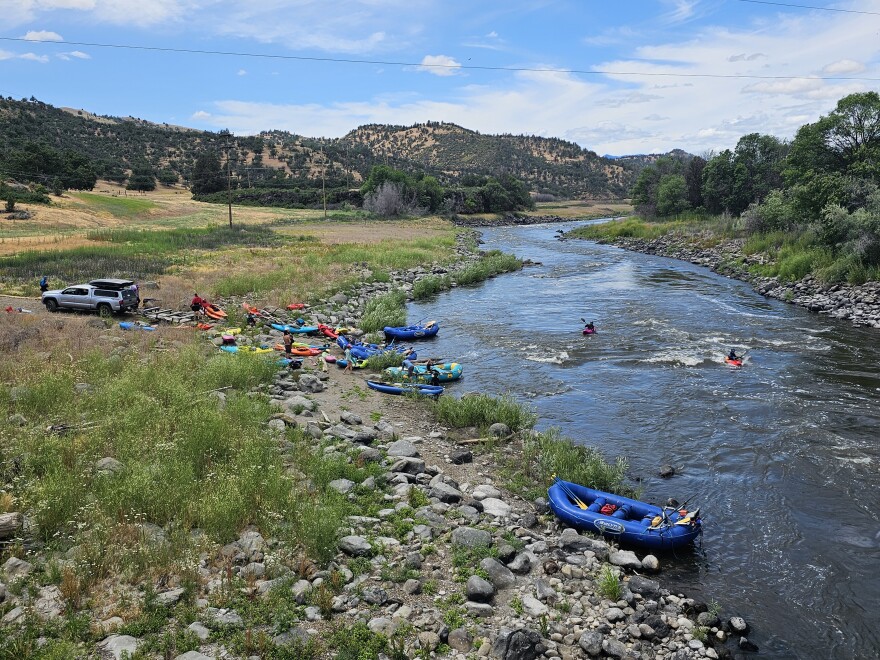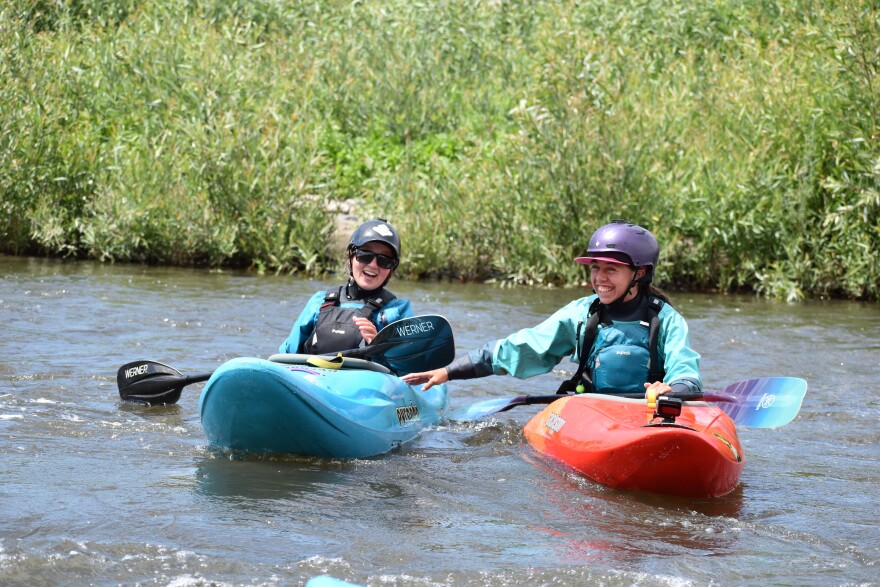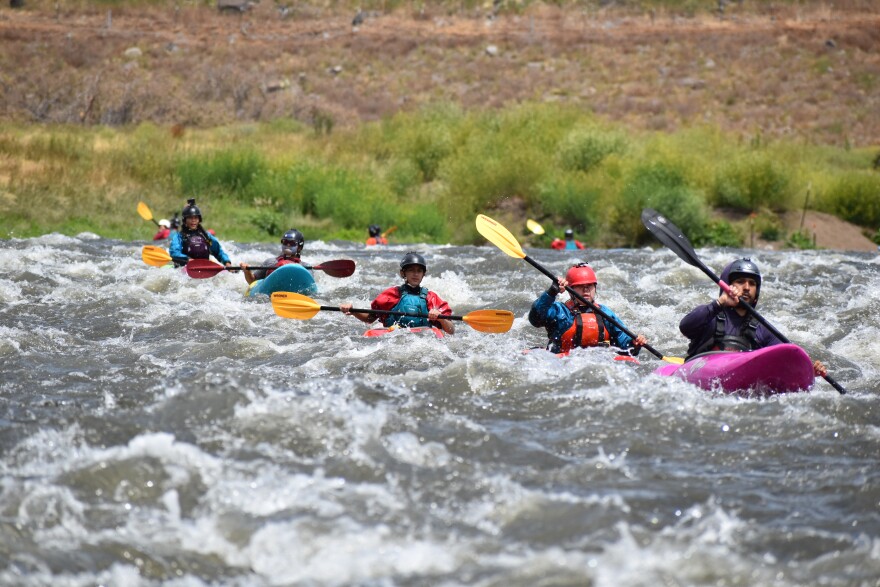Just before launching their kayaks into the teal-green Wood River, a group of 15 Indigenous youth gathered on the morning of June 12 for last-minute safety checks.
“Stay on inside of the bends where the water is slower,” said Ben Morton, the lead kayak instructor for Paddle Tribal Waters. “Just because there are no major rapids doesn’t mean there’s no hazards.”
The students, part of Paddle Tribal Waters, were preparing to paddle the entire Klamath River — from its headwaters in southern Oregon to its mouth on the northern California coast. It’s the first time the route has been possible in more than a century. Four dams came down in 2023 and 2024, reconnecting the river’s main stem.
Ranging in age from 13 to 20, the students hail from tribes across the vast watershed. Minutes before, they were typical teenagers—picking each other up, fussing with gear and laughing.
Now, wearing life jackets and kayaking skirts, with zinc-painted faces and GoPro cameras strapped to their helmets, they were all business.

Some of them have been training for three years to prepare for this momentous journey.
“They’re ready,” said Danielle “Ducky” Franke Colegrove, a youth instructor who is Hoopa and Yurok.
But whitewater kayaking is not just about running the biggest rapids, she said. “It’s about committing to being in a relationship with the river. Most of them made that commitment long before they met us.”
For over a century, dams blocked fish runs from hundreds of miles of the Klamath and its upper tributaries. Now, spawning salmon have found their way into streams that had long been inaccessible. Colegrove calls the first descent a healing journey and a celebration of long-fought-for dam removal.
“I’ve been involved with river warrior work my whole life,” said Colegrove, who was born in 2002, the same year a massive fish kill, brought on by warm temperatures and compromised river flows, devastated the lower Klamath. “Ever since colonization, we’ve been living with little pieces of who we’re actually supposed to be,” Colegrove said. “I’m hoping with these dams down, all of us will be able to reconnect once more.”
One by one, the paddlers climbed into their boats and scooted, seal-like, into the river. There, the kayaks—bright, fat shells in an assortment of rainbow colors—became graceful and nimble as they spread out over the water. Supporters trailed after the youth in their own kayaks, while friends, family members, and Tribal elders stood on the banks, waving and cheering them on.

Though they will still have to portage around two remaining dams in Oregon — Link River and Keno — over the next 33 days, these young people will experience a river in recovery.
Soon, the brightly colored boats disappeared around the bend.
Like young salmon leaving their natal stream, their journey was just beginning.
Building tribal connections through kayaking
Paddle Tribal Waters is a program of Rios to Rivers, which Weston Boyles started after meeting kids from a kayaking club on Chile’s Baker River. At the time, club members were fighting an enormous hydroelectric project planned for the Baker and Pascua Rivers. Five dams would have produced 20% of the country’s energy — but utterly transformed and degraded the rivers.
Recognizing the young kayakers were powerful advocates for the rivers, Boyles decided to make a film about them. He soon learned none of them had even seen a dam.
“That was this moment of, what if we could create an exchange program where kids could jump in a time machine and see the future of what their river could look like if dams were built,” Boyles said.
Ashia Wilson, a member of the Klamath Tribes, attended a Rios to Rivers program on the Klamath before traveling to Chile on an exchange.
The Chilean paddlers got to witness the damage dams cause, and “We got to see a predammed river,” Wilson said. “It was a very eye-opening experience for both groups involved.”
Shortly afterward, she and her brother Paul formed Maqlaqs, an Indigenous paddling club.
Paul, an avid whitewater kayaker, struggled to find other native paddlers. “He was inspired to make it a point to provide space, gear and skills to our kids,” Wilson said. “So that way, this next generation coming up would have the opportunity to whitewater kayak.”

In 2022, Maqlaqs, Rios to Rivers and kayaker Rush Sturges collaborated to form Paddle Tribal Waters.
“We realized that a powerful part of the program was connecting kids from the Upper Basin of Klamath with kids from the Lower Basin,” Boyles said.
Three cohorts have been preparing for this first descent.
Fourteen-year-old Coley Miller said her mother encouraged her to give it a try. “I was really shy,” said Miller, who is from the Klamath Tribes. “After joining, I just kind of opened up.”
Keeya Wiki, who is Yurok and Maori, was also prompted by her mother to join a cohort two years ago. Now, she has a family of close friends, including the instructors.
“They’re very silly, funny, outgoing adults,” she said. “But they also know how to live on a river.”
The instructors also learn from the kids. “They want to know more about us,” Keeya Wiki said. “They ask a lot of questions about the river, about the basin, about our ceremonies, traditions and outlook on things.”
Taking it to the next level
Some of the kids have also enrolled in Paddle Tribal Waters Academy, a semester-long traveling high school built around kayaking.
A typical Academy day starts early with a workout before breakfast, followed by a full day of high school. Rios to Rivers collaborates with World Class Academy to provide an indigenized curriculum that’s relevant to the students. They also spend at least two hours kayaking before dinner.

“Kayaking is one of those sports that requires hours in the boat,” Boyles said. “These kids have years under their belts to be able to paddle these hard, challenging, technical and dangerous sections of the Klamath.”
Ruby Williams, who is Karuk and an enrolled member of the Quartz Valley Tribe, is one of the more experienced paddlers. She spent part of her junior year and her entire senior year abroad, traveling in Africa, Chile and Canada. She’s heading to Colorado for college in the fall, but plans to pursue further training with a Paddle Tribal Waters instructor who lives there.
“It’s been one of my biggest goals as soon as I became a kayaker is to learn how to instruct so I can be a role model and someone that could be there for them in a way that they need,” said Williams, who just turned 18. “There’s certain things native kids need from a native mentor.”
Klamath River challenges test young paddlers
After a calm morning floating down the Wood River, the group faced its first test: fighting late afternoon headwinds on Upper Klamath Lake.
Physical challenge and exposure to the elements are an important part of a long expedition like this, said Colegrove. “We live lives of comfort pretty much. It’s not a bad thing, but it makes us a little bit weaker,” she said. “Getting stronger is hard. It comes with discomfort.”
The next trial was the Hell’s Corner reach, a gauntlet of Class 4 rapids right near the Oregon-California border.

The paddlers are exploring reaches that no one has been able to run for generations, including Kikaceki Canyon.
This spectacular gorge was largely dewatered while the Copco 2 dam was in place. Trees and brush that for decades took root in the dry riverbed were torn out as part of the dam removal project, so they wouldn’t present hazards to rafters and boaters.
Copco 2 was demolished in late 2023, allowing water to flow freely through Kikaceki Canyon. For the Shasta Indian Nation, the canyon is more than a whitewater run – it’s a sacred part of their ancestral homelands. Last year, California announced it intends to return 2,800 acres of formerly submerged land to the tribe.
Kikaceki Canyon is also a whitewater kayaker’s dream, with technically challenging Class 4 and Class 4-plus rapids. Less experienced paddlers opted to navigate this section on guided rafts from Momentum River Expeditions.
Others, like Williams, took it on in kayaks.
“It’s probably my favorite run on the Klamath,” she said.
She called the basalt columns that form the canyon walls “the most beautiful things ever.”
“It makes you realize how tiny you are,” Williams said. “Then you go around the corner and there’s this awesome whitewater.”
Through the Iron Gate
In the early afternoon on July 22, the paddlers climbed back in their boats and put in just downstream of Kikaceki Canyon. This next reach would take them through a landscape that, until recently, had been submerged under Iron Gate reservoir for more than 60 years.

The paddlers took turns shooting through short series of Class 1 and Class 2 rapids, showing off their skills, many grinning. In the flat, calm sections between rapids, they had time to take in the recovering landscape.
Tributaries like Jenny Creek, once clogged and stagnant with green algae, now flowed freely into the river. Flanking the river, native grasses and wildflowers planted by restoration crews turned gold in the summer sun. Closer to Iron Gate, blocky chunks of dried mud were topped with a fresh crown of thick willows.
As the paddlers approached Iron Gate, the canyon narrowed and passing clouds cast dramatic shadows on the basalt walls. Just two years before, a 173-foot-tall earthen dam plugged the river here. Last year, crews hauled thousands of truckloads of earth and rock back to the nearby hill where it was originally excavated. Now, that hill is crowned with the light green fuzz of new vegetation.
The kayakers paddled through the canyon, as freely as fish.
A few miles downriver, the group took out at R Ranch. After 11 days on the river, they worked as one, hanging wet gear and stowing boats and paddles.

“We’re in it,” Wiki said. “We have our routines down. We’re in first descent mode, in Paddle Tribal Waters mode — completely outside of our ‘real lives.’”
With nearly 200 miles still to go, there are still plenty of challenges ahead, like long, hot days on the Mid Klamath. But the paddlers are also looking forward to more milestones.
In Happy Camp, the group is planning a community day, where they’ll host raft trips and reunite with other kids from their cohorts. Closer to Requa, California, near where the Klamath meets the Pacific, a contingent of international paddlers, including some they met in Chile, will join them for the final leg.
For Wiki, who grew up in a family of activists, the journey is about more than reaching a destination.
“I’m paddling home,” she said. “I’m so excited to get to Requa.”



